Marketing Strategy - Volkswagen Electronic Vehicle in Japan Market
VerifiedAdded on 2022/10/17
|33
|5672
|10
Report
AI Summary
This report provides a comprehensive marketing strategy for Volkswagen's electric vehicle (EV) entry into the Japanese market. It begins with an executive summary outlining the key findings, including market analysis, and the use of PESTLE, Hofstede, and CAGE models to assess the market conditions, cultural factors, and geographical advantages. The report analyzes the political, economic, social, technological, legal, and environmental factors impacting the market entry. It also assesses cultural differences between Japan and Germany using Hofstede's model and examines the economic advantages of producing and selling EVs in Japan through the CAGE model. Furthermore, the report includes company and customer analysis, situation analysis, objectives, strategies for market entry and sustenance, segmentation, targeting, positioning, and a detailed marketing mix with actions and control measures. The report also includes a competitor analysis and discusses the factors that would facilitate the market entry of the organization in the Japanese market with EV cars. Finally, the report suggests how Volkswagen can achieve its target of expanding the market share of Volkswagen EV and developing gross margins.

Running Head: MARKETING STRATEGY - PUTTING A VOLKSWAGEN ELECTRONIC VEHICLE INTO
THE JAPAN MARKET.
Marketing Strategy - Putting a Volkswagen Electronic Vehicle into the Japan Market.
Student’s Name
University Name
Author’s Note
THE JAPAN MARKET.
Marketing Strategy - Putting a Volkswagen Electronic Vehicle into the Japan Market.
Student’s Name
University Name
Author’s Note
Paraphrase This Document
Need a fresh take? Get an instant paraphrase of this document with our AI Paraphraser
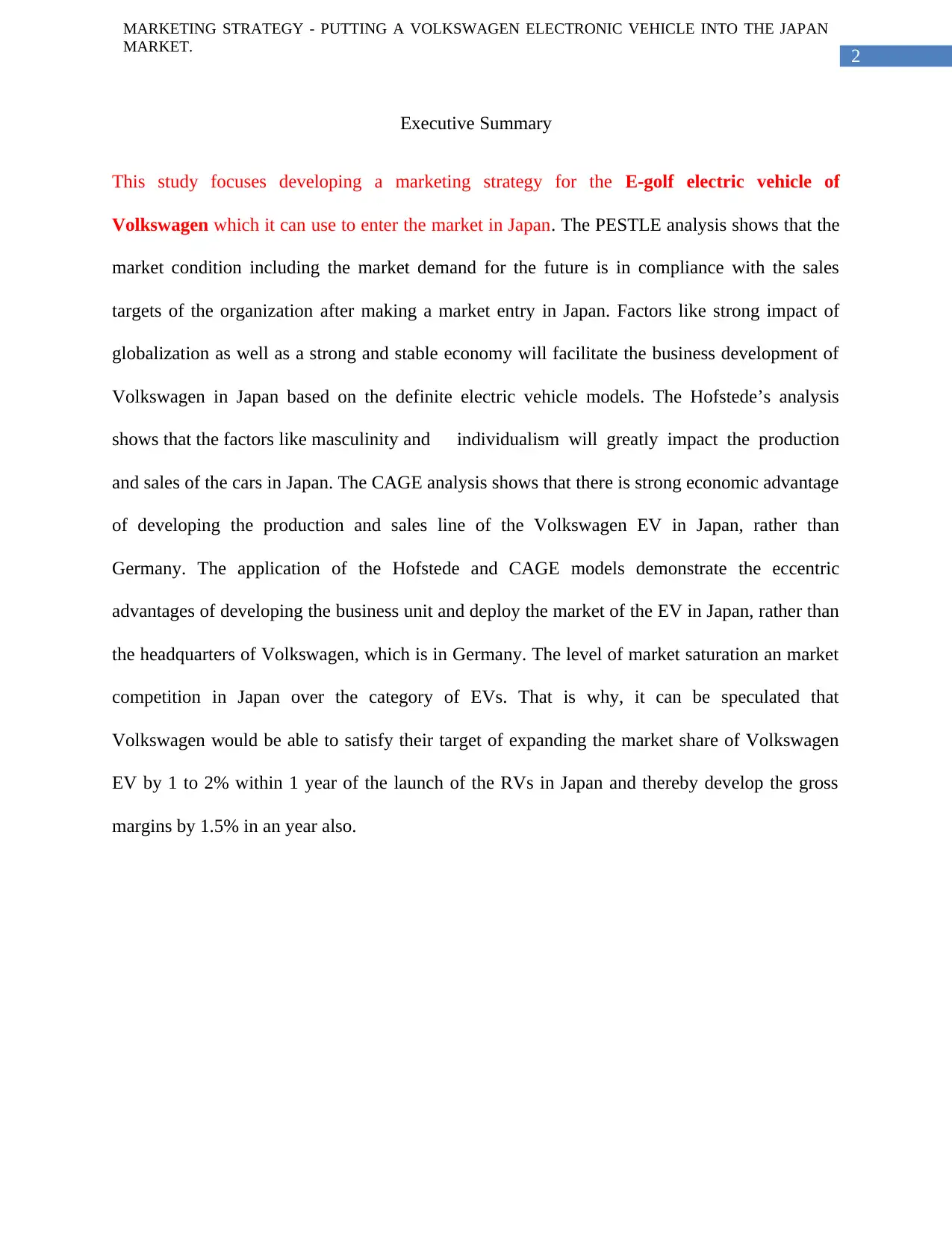
MARKETING STRATEGY - PUTTING A VOLKSWAGEN ELECTRONIC VEHICLE INTO THE JAPAN
MARKET. 2
Executive Summary
This study focuses developing a marketing strategy for the E-golf electric vehicle of
Volkswagen which it can use to enter the market in Japan. The PESTLE analysis shows that the
market condition including the market demand for the future is in compliance with the sales
targets of the organization after making a market entry in Japan. Factors like strong impact of
globalization as well as a strong and stable economy will facilitate the business development of
Volkswagen in Japan based on the definite electric vehicle models. The Hofstede’s analysis
shows that the factors like masculinity and individualism will greatly impact the production
and sales of the cars in Japan. The CAGE analysis shows that there is strong economic advantage
of developing the production and sales line of the Volkswagen EV in Japan, rather than
Germany. The application of the Hofstede and CAGE models demonstrate the eccentric
advantages of developing the business unit and deploy the market of the EV in Japan, rather than
the headquarters of Volkswagen, which is in Germany. The level of market saturation an market
competition in Japan over the category of EVs. That is why, it can be speculated that
Volkswagen would be able to satisfy their target of expanding the market share of Volkswagen
EV by 1 to 2% within 1 year of the launch of the RVs in Japan and thereby develop the gross
margins by 1.5% in an year also.
MARKET. 2
Executive Summary
This study focuses developing a marketing strategy for the E-golf electric vehicle of
Volkswagen which it can use to enter the market in Japan. The PESTLE analysis shows that the
market condition including the market demand for the future is in compliance with the sales
targets of the organization after making a market entry in Japan. Factors like strong impact of
globalization as well as a strong and stable economy will facilitate the business development of
Volkswagen in Japan based on the definite electric vehicle models. The Hofstede’s analysis
shows that the factors like masculinity and individualism will greatly impact the production
and sales of the cars in Japan. The CAGE analysis shows that there is strong economic advantage
of developing the production and sales line of the Volkswagen EV in Japan, rather than
Germany. The application of the Hofstede and CAGE models demonstrate the eccentric
advantages of developing the business unit and deploy the market of the EV in Japan, rather than
the headquarters of Volkswagen, which is in Germany. The level of market saturation an market
competition in Japan over the category of EVs. That is why, it can be speculated that
Volkswagen would be able to satisfy their target of expanding the market share of Volkswagen
EV by 1 to 2% within 1 year of the launch of the RVs in Japan and thereby develop the gross
margins by 1.5% in an year also.
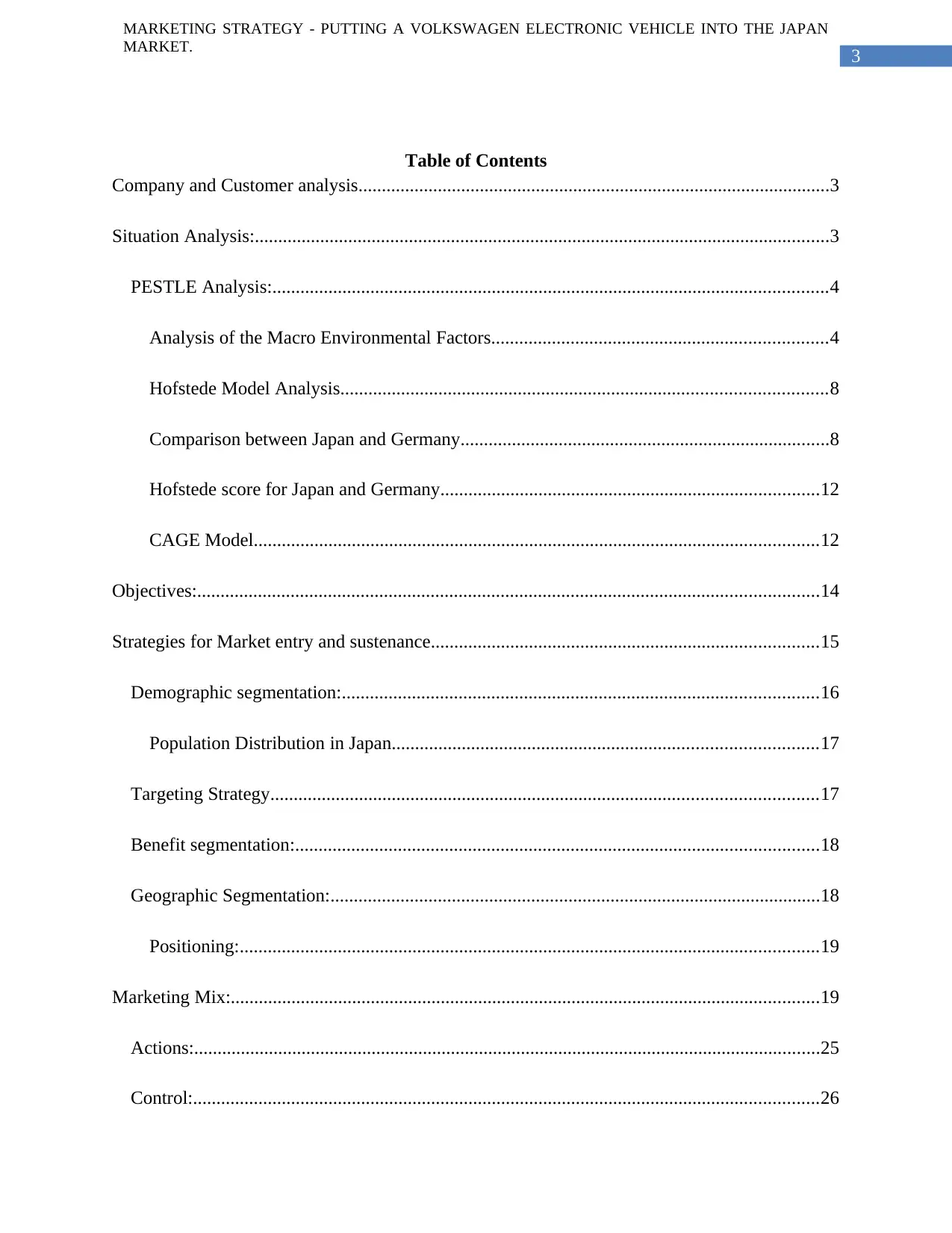
3
MARKETING STRATEGY - PUTTING A VOLKSWAGEN ELECTRONIC VEHICLE INTO THE JAPAN
MARKET.
Table of Contents
Company and Customer analysis.....................................................................................................3
Situation Analysis:...........................................................................................................................3
PESTLE Analysis:.......................................................................................................................4
Analysis of the Macro Environmental Factors........................................................................4
Hofstede Model Analysis........................................................................................................8
Comparison between Japan and Germany...............................................................................8
Hofstede score for Japan and Germany.................................................................................12
CAGE Model.........................................................................................................................12
Objectives:.....................................................................................................................................14
Strategies for Market entry and sustenance...................................................................................15
Demographic segmentation:......................................................................................................16
Population Distribution in Japan...........................................................................................17
Targeting Strategy.....................................................................................................................17
Benefit segmentation:................................................................................................................18
Geographic Segmentation:.........................................................................................................18
Positioning:............................................................................................................................19
Marketing Mix:..............................................................................................................................19
Actions:......................................................................................................................................25
Control:......................................................................................................................................26
MARKETING STRATEGY - PUTTING A VOLKSWAGEN ELECTRONIC VEHICLE INTO THE JAPAN
MARKET.
Table of Contents
Company and Customer analysis.....................................................................................................3
Situation Analysis:...........................................................................................................................3
PESTLE Analysis:.......................................................................................................................4
Analysis of the Macro Environmental Factors........................................................................4
Hofstede Model Analysis........................................................................................................8
Comparison between Japan and Germany...............................................................................8
Hofstede score for Japan and Germany.................................................................................12
CAGE Model.........................................................................................................................12
Objectives:.....................................................................................................................................14
Strategies for Market entry and sustenance...................................................................................15
Demographic segmentation:......................................................................................................16
Population Distribution in Japan...........................................................................................17
Targeting Strategy.....................................................................................................................17
Benefit segmentation:................................................................................................................18
Geographic Segmentation:.........................................................................................................18
Positioning:............................................................................................................................19
Marketing Mix:..............................................................................................................................19
Actions:......................................................................................................................................25
Control:......................................................................................................................................26
⊘ This is a preview!⊘
Do you want full access?
Subscribe today to unlock all pages.

Trusted by 1+ million students worldwide

4
MARKETING STRATEGY - PUTTING A VOLKSWAGEN ELECTRONIC VEHICLE INTO THE JAPAN
MARKET.
MARKETING STRATEGY - PUTTING A VOLKSWAGEN ELECTRONIC VEHICLE INTO THE JAPAN
MARKET.
Paraphrase This Document
Need a fresh take? Get an instant paraphrase of this document with our AI Paraphraser

5
MARKETING STRATEGY - PUTTING A VOLKSWAGEN ELECTRONIC VEHICLE INTO THE JAPAN
MARKET.
Company and Customer analysis
Volkswagen is the leading car manufacturer in the world with headquarters in Wolfsburg,
Germany. The annual unit production of Volkswagen is over 10 million (Frue 2016). This is the
reason why the organization has the highest brand as well as product portfolio. In Europe, the
organization is reputed as the biggest car manufacturer. Again, Volkswagen has their biggest
market in China. Hence, from a strategic point of view, the market entry in to the Japanese
market is very important (Frue 2016). The factors that would be facilitating the market entry of
the organization in the Japanese market with EV cars have been detailed in the later parts of the
report. Nevertheless, after the dieselgate scandal, the company has experienced serious damage
over their brand reputation and lost major proportion of sales (Frue 2016). This is why they need
an alternative product line that can be introduced in a new market with an absolutely clean
market reputation.
The brand reputation of Volkswagen over the sales of EVs depends mostly on the
increase in deliveries to the customers and the quality of customer service that they would be
able to provide to the customers of Japan. Although, the customers of cars in Japan have been
identified to be fascinated over lifestyle products, which include cars, the introduction of the EVs
in Japan would be highly profitable if they introduce the car models on a moderate budget line
(Frue 2016).
Situation Analysis:
In situation analysis, the researcher has got most widely used tactics and tools such as PESLE
analysis, CAGE Model along with Hofstede model with some focus on competitors for
Volkswagen new Electric car e-Golf.
MARKETING STRATEGY - PUTTING A VOLKSWAGEN ELECTRONIC VEHICLE INTO THE JAPAN
MARKET.
Company and Customer analysis
Volkswagen is the leading car manufacturer in the world with headquarters in Wolfsburg,
Germany. The annual unit production of Volkswagen is over 10 million (Frue 2016). This is the
reason why the organization has the highest brand as well as product portfolio. In Europe, the
organization is reputed as the biggest car manufacturer. Again, Volkswagen has their biggest
market in China. Hence, from a strategic point of view, the market entry in to the Japanese
market is very important (Frue 2016). The factors that would be facilitating the market entry of
the organization in the Japanese market with EV cars have been detailed in the later parts of the
report. Nevertheless, after the dieselgate scandal, the company has experienced serious damage
over their brand reputation and lost major proportion of sales (Frue 2016). This is why they need
an alternative product line that can be introduced in a new market with an absolutely clean
market reputation.
The brand reputation of Volkswagen over the sales of EVs depends mostly on the
increase in deliveries to the customers and the quality of customer service that they would be
able to provide to the customers of Japan. Although, the customers of cars in Japan have been
identified to be fascinated over lifestyle products, which include cars, the introduction of the EVs
in Japan would be highly profitable if they introduce the car models on a moderate budget line
(Frue 2016).
Situation Analysis:
In situation analysis, the researcher has got most widely used tactics and tools such as PESLE
analysis, CAGE Model along with Hofstede model with some focus on competitors for
Volkswagen new Electric car e-Golf.
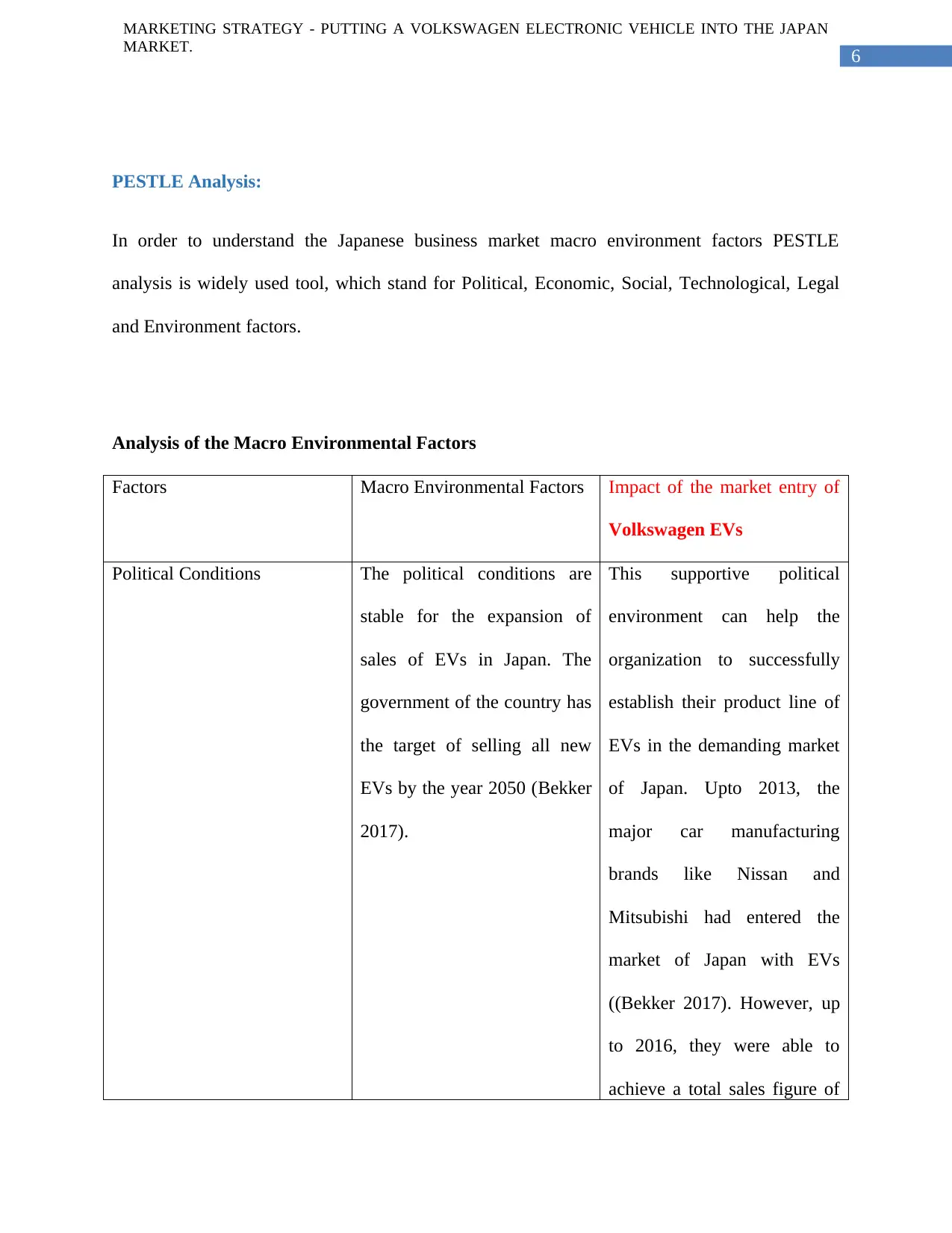
6
MARKETING STRATEGY - PUTTING A VOLKSWAGEN ELECTRONIC VEHICLE INTO THE JAPAN
MARKET.
PESTLE Analysis:
In order to understand the Japanese business market macro environment factors PESTLE
analysis is widely used tool, which stand for Political, Economic, Social, Technological, Legal
and Environment factors.
Analysis of the Macro Environmental Factors
Factors Macro Environmental Factors Impact of the market entry of
Volkswagen EVs
Political Conditions The political conditions are
stable for the expansion of
sales of EVs in Japan. The
government of the country has
the target of selling all new
EVs by the year 2050 (Bekker
2017).
This supportive political
environment can help the
organization to successfully
establish their product line of
EVs in the demanding market
of Japan. Upto 2013, the
major car manufacturing
brands like Nissan and
Mitsubishi had entered the
market of Japan with EVs
((Bekker 2017). However, up
to 2016, they were able to
achieve a total sales figure of
MARKETING STRATEGY - PUTTING A VOLKSWAGEN ELECTRONIC VEHICLE INTO THE JAPAN
MARKET.
PESTLE Analysis:
In order to understand the Japanese business market macro environment factors PESTLE
analysis is widely used tool, which stand for Political, Economic, Social, Technological, Legal
and Environment factors.
Analysis of the Macro Environmental Factors
Factors Macro Environmental Factors Impact of the market entry of
Volkswagen EVs
Political Conditions The political conditions are
stable for the expansion of
sales of EVs in Japan. The
government of the country has
the target of selling all new
EVs by the year 2050 (Bekker
2017).
This supportive political
environment can help the
organization to successfully
establish their product line of
EVs in the demanding market
of Japan. Upto 2013, the
major car manufacturing
brands like Nissan and
Mitsubishi had entered the
market of Japan with EVs
((Bekker 2017). However, up
to 2016, they were able to
achieve a total sales figure of
⊘ This is a preview!⊘
Do you want full access?
Subscribe today to unlock all pages.

Trusted by 1+ million students worldwide
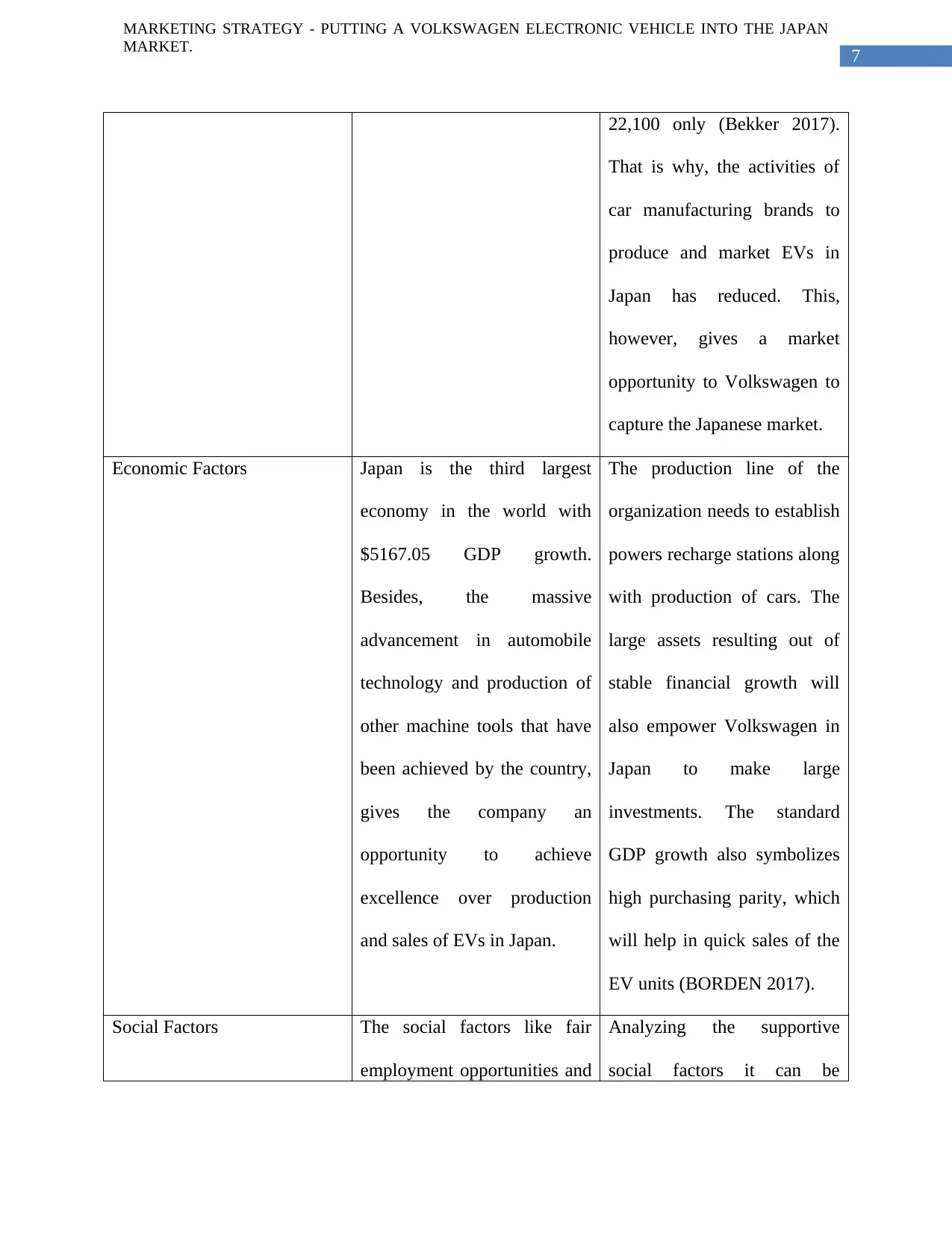
7
MARKETING STRATEGY - PUTTING A VOLKSWAGEN ELECTRONIC VEHICLE INTO THE JAPAN
MARKET.
22,100 only (Bekker 2017).
That is why, the activities of
car manufacturing brands to
produce and market EVs in
Japan has reduced. This,
however, gives a market
opportunity to Volkswagen to
capture the Japanese market.
Economic Factors Japan is the third largest
economy in the world with
$5167.05 GDP growth.
Besides, the massive
advancement in automobile
technology and production of
other machine tools that have
been achieved by the country,
gives the company an
opportunity to achieve
excellence over production
and sales of EVs in Japan.
The production line of the
organization needs to establish
powers recharge stations along
with production of cars. The
large assets resulting out of
stable financial growth will
also empower Volkswagen in
Japan to make large
investments. The standard
GDP growth also symbolizes
high purchasing parity, which
will help in quick sales of the
EV units (BORDEN 2017).
Social Factors The social factors like fair
employment opportunities and
Analyzing the supportive
social factors it can be
MARKETING STRATEGY - PUTTING A VOLKSWAGEN ELECTRONIC VEHICLE INTO THE JAPAN
MARKET.
22,100 only (Bekker 2017).
That is why, the activities of
car manufacturing brands to
produce and market EVs in
Japan has reduced. This,
however, gives a market
opportunity to Volkswagen to
capture the Japanese market.
Economic Factors Japan is the third largest
economy in the world with
$5167.05 GDP growth.
Besides, the massive
advancement in automobile
technology and production of
other machine tools that have
been achieved by the country,
gives the company an
opportunity to achieve
excellence over production
and sales of EVs in Japan.
The production line of the
organization needs to establish
powers recharge stations along
with production of cars. The
large assets resulting out of
stable financial growth will
also empower Volkswagen in
Japan to make large
investments. The standard
GDP growth also symbolizes
high purchasing parity, which
will help in quick sales of the
EV units (BORDEN 2017).
Social Factors The social factors like fair
employment opportunities and
Analyzing the supportive
social factors it can be
Paraphrase This Document
Need a fresh take? Get an instant paraphrase of this document with our AI Paraphraser
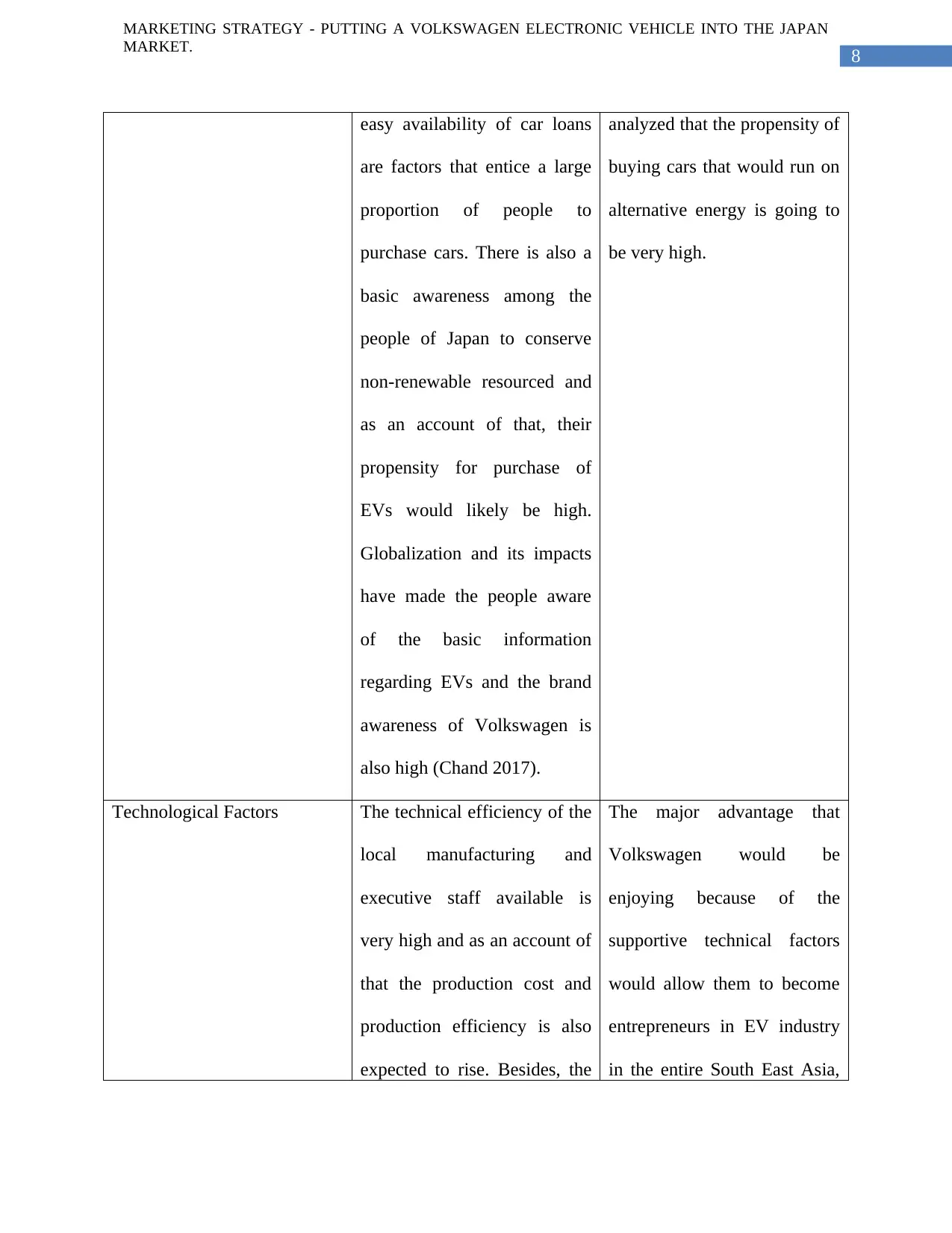
8
MARKETING STRATEGY - PUTTING A VOLKSWAGEN ELECTRONIC VEHICLE INTO THE JAPAN
MARKET.
easy availability of car loans
are factors that entice a large
proportion of people to
purchase cars. There is also a
basic awareness among the
people of Japan to conserve
non-renewable resourced and
as an account of that, their
propensity for purchase of
EVs would likely be high.
Globalization and its impacts
have made the people aware
of the basic information
regarding EVs and the brand
awareness of Volkswagen is
also high (Chand 2017).
analyzed that the propensity of
buying cars that would run on
alternative energy is going to
be very high.
Technological Factors The technical efficiency of the
local manufacturing and
executive staff available is
very high and as an account of
that the production cost and
production efficiency is also
expected to rise. Besides, the
The major advantage that
Volkswagen would be
enjoying because of the
supportive technical factors
would allow them to become
entrepreneurs in EV industry
in the entire South East Asia,
MARKETING STRATEGY - PUTTING A VOLKSWAGEN ELECTRONIC VEHICLE INTO THE JAPAN
MARKET.
easy availability of car loans
are factors that entice a large
proportion of people to
purchase cars. There is also a
basic awareness among the
people of Japan to conserve
non-renewable resourced and
as an account of that, their
propensity for purchase of
EVs would likely be high.
Globalization and its impacts
have made the people aware
of the basic information
regarding EVs and the brand
awareness of Volkswagen is
also high (Chand 2017).
analyzed that the propensity of
buying cars that would run on
alternative energy is going to
be very high.
Technological Factors The technical efficiency of the
local manufacturing and
executive staff available is
very high and as an account of
that the production cost and
production efficiency is also
expected to rise. Besides, the
The major advantage that
Volkswagen would be
enjoying because of the
supportive technical factors
would allow them to become
entrepreneurs in EV industry
in the entire South East Asia,
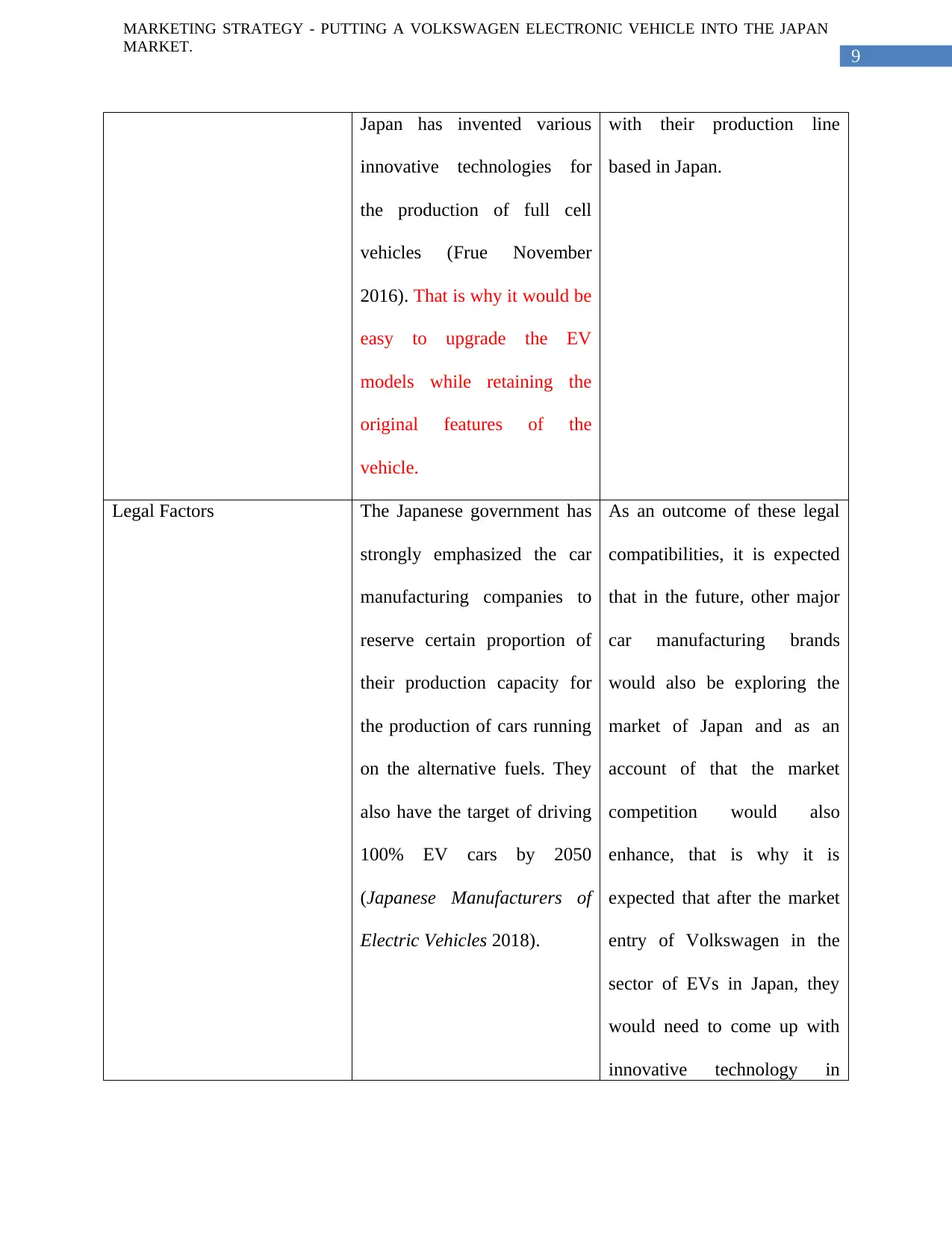
9
MARKETING STRATEGY - PUTTING A VOLKSWAGEN ELECTRONIC VEHICLE INTO THE JAPAN
MARKET.
Japan has invented various
innovative technologies for
the production of full cell
vehicles (Frue November
2016). That is why it would be
easy to upgrade the EV
models while retaining the
original features of the
vehicle.
with their production line
based in Japan.
Legal Factors The Japanese government has
strongly emphasized the car
manufacturing companies to
reserve certain proportion of
their production capacity for
the production of cars running
on the alternative fuels. They
also have the target of driving
100% EV cars by 2050
(Japanese Manufacturers of
Electric Vehicles 2018).
As an outcome of these legal
compatibilities, it is expected
that in the future, other major
car manufacturing brands
would also be exploring the
market of Japan and as an
account of that the market
competition would also
enhance, that is why it is
expected that after the market
entry of Volkswagen in the
sector of EVs in Japan, they
would need to come up with
innovative technology in
MARKETING STRATEGY - PUTTING A VOLKSWAGEN ELECTRONIC VEHICLE INTO THE JAPAN
MARKET.
Japan has invented various
innovative technologies for
the production of full cell
vehicles (Frue November
2016). That is why it would be
easy to upgrade the EV
models while retaining the
original features of the
vehicle.
with their production line
based in Japan.
Legal Factors The Japanese government has
strongly emphasized the car
manufacturing companies to
reserve certain proportion of
their production capacity for
the production of cars running
on the alternative fuels. They
also have the target of driving
100% EV cars by 2050
(Japanese Manufacturers of
Electric Vehicles 2018).
As an outcome of these legal
compatibilities, it is expected
that in the future, other major
car manufacturing brands
would also be exploring the
market of Japan and as an
account of that the market
competition would also
enhance, that is why it is
expected that after the market
entry of Volkswagen in the
sector of EVs in Japan, they
would need to come up with
innovative technology in
⊘ This is a preview!⊘
Do you want full access?
Subscribe today to unlock all pages.

Trusted by 1+ million students worldwide

10
MARKETING STRATEGY - PUTTING A VOLKSWAGEN ELECTRONIC VEHICLE INTO THE JAPAN
MARKET.
regular intervals so that they
are able to stay ahead in the
competition.
Environmental Factors The manufacturing industries
are centered mostly on Tokyo
in Japan, which is very much
prone to industrial disasters
( Marsh December 2018).
Any accidental damage caused
to the production units
(chances are always high and
prevailing) will cause great
financial losses for the
organization.
Table 1: PESTLE Analysis
(Source: Developed by the researcher)
Hofstede Model Analysis
In order to clearly understand the cultural differences and values which ultimately shape
Japanese behavior and affect their lifestyle, for to introduce new EV car this model helps
Volkswagen to target Japanese market accordingly. The production leader with up to 13 million
cars per year manufactured and exported (Japanese Manufacturers of Electric Vehicles, 2018).
Electric vehicle business is not that much advanced and expanded so that new entrepreneurs feel
hesitation in entering in this competitive market.
In order to fully understand Japanese Lifestyle let’s compare Japanese cultural dimensions with
Germany through this model.
MARKETING STRATEGY - PUTTING A VOLKSWAGEN ELECTRONIC VEHICLE INTO THE JAPAN
MARKET.
regular intervals so that they
are able to stay ahead in the
competition.
Environmental Factors The manufacturing industries
are centered mostly on Tokyo
in Japan, which is very much
prone to industrial disasters
( Marsh December 2018).
Any accidental damage caused
to the production units
(chances are always high and
prevailing) will cause great
financial losses for the
organization.
Table 1: PESTLE Analysis
(Source: Developed by the researcher)
Hofstede Model Analysis
In order to clearly understand the cultural differences and values which ultimately shape
Japanese behavior and affect their lifestyle, for to introduce new EV car this model helps
Volkswagen to target Japanese market accordingly. The production leader with up to 13 million
cars per year manufactured and exported (Japanese Manufacturers of Electric Vehicles, 2018).
Electric vehicle business is not that much advanced and expanded so that new entrepreneurs feel
hesitation in entering in this competitive market.
In order to fully understand Japanese Lifestyle let’s compare Japanese cultural dimensions with
Germany through this model.
Paraphrase This Document
Need a fresh take? Get an instant paraphrase of this document with our AI Paraphraser
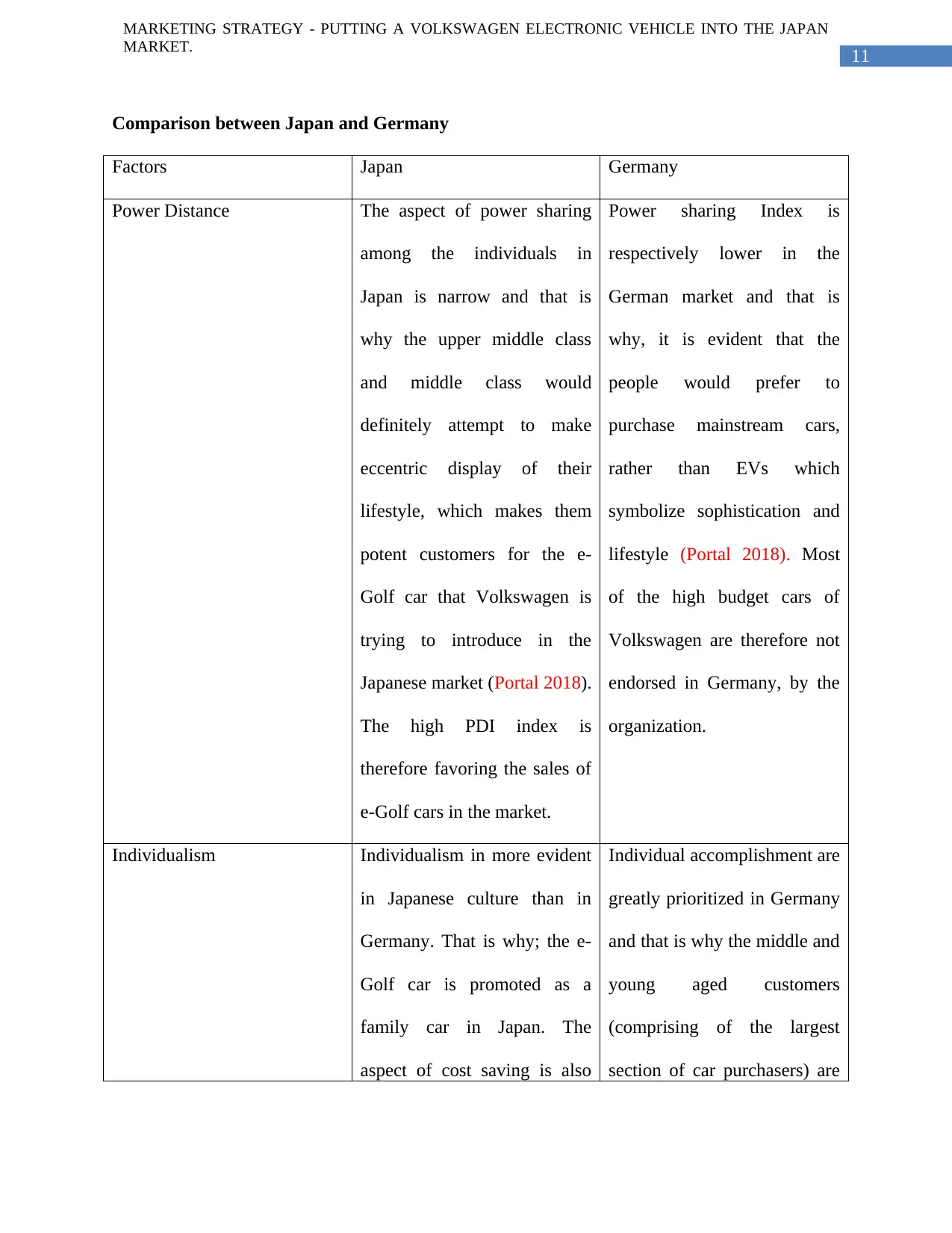
11
MARKETING STRATEGY - PUTTING A VOLKSWAGEN ELECTRONIC VEHICLE INTO THE JAPAN
MARKET.
Comparison between Japan and Germany
Factors Japan Germany
Power Distance The aspect of power sharing
among the individuals in
Japan is narrow and that is
why the upper middle class
and middle class would
definitely attempt to make
eccentric display of their
lifestyle, which makes them
potent customers for the e-
Golf car that Volkswagen is
trying to introduce in the
Japanese market (Portal 2018).
The high PDI index is
therefore favoring the sales of
e-Golf cars in the market.
Power sharing Index is
respectively lower in the
German market and that is
why, it is evident that the
people would prefer to
purchase mainstream cars,
rather than EVs which
symbolize sophistication and
lifestyle (Portal 2018). Most
of the high budget cars of
Volkswagen are therefore not
endorsed in Germany, by the
organization.
Individualism Individualism in more evident
in Japanese culture than in
Germany. That is why; the e-
Golf car is promoted as a
family car in Japan. The
aspect of cost saving is also
Individual accomplishment are
greatly prioritized in Germany
and that is why the middle and
young aged customers
(comprising of the largest
section of car purchasers) are
MARKETING STRATEGY - PUTTING A VOLKSWAGEN ELECTRONIC VEHICLE INTO THE JAPAN
MARKET.
Comparison between Japan and Germany
Factors Japan Germany
Power Distance The aspect of power sharing
among the individuals in
Japan is narrow and that is
why the upper middle class
and middle class would
definitely attempt to make
eccentric display of their
lifestyle, which makes them
potent customers for the e-
Golf car that Volkswagen is
trying to introduce in the
Japanese market (Portal 2018).
The high PDI index is
therefore favoring the sales of
e-Golf cars in the market.
Power sharing Index is
respectively lower in the
German market and that is
why, it is evident that the
people would prefer to
purchase mainstream cars,
rather than EVs which
symbolize sophistication and
lifestyle (Portal 2018). Most
of the high budget cars of
Volkswagen are therefore not
endorsed in Germany, by the
organization.
Individualism Individualism in more evident
in Japanese culture than in
Germany. That is why; the e-
Golf car is promoted as a
family car in Japan. The
aspect of cost saving is also
Individual accomplishment are
greatly prioritized in Germany
and that is why the middle and
young aged customers
(comprising of the largest
section of car purchasers) are
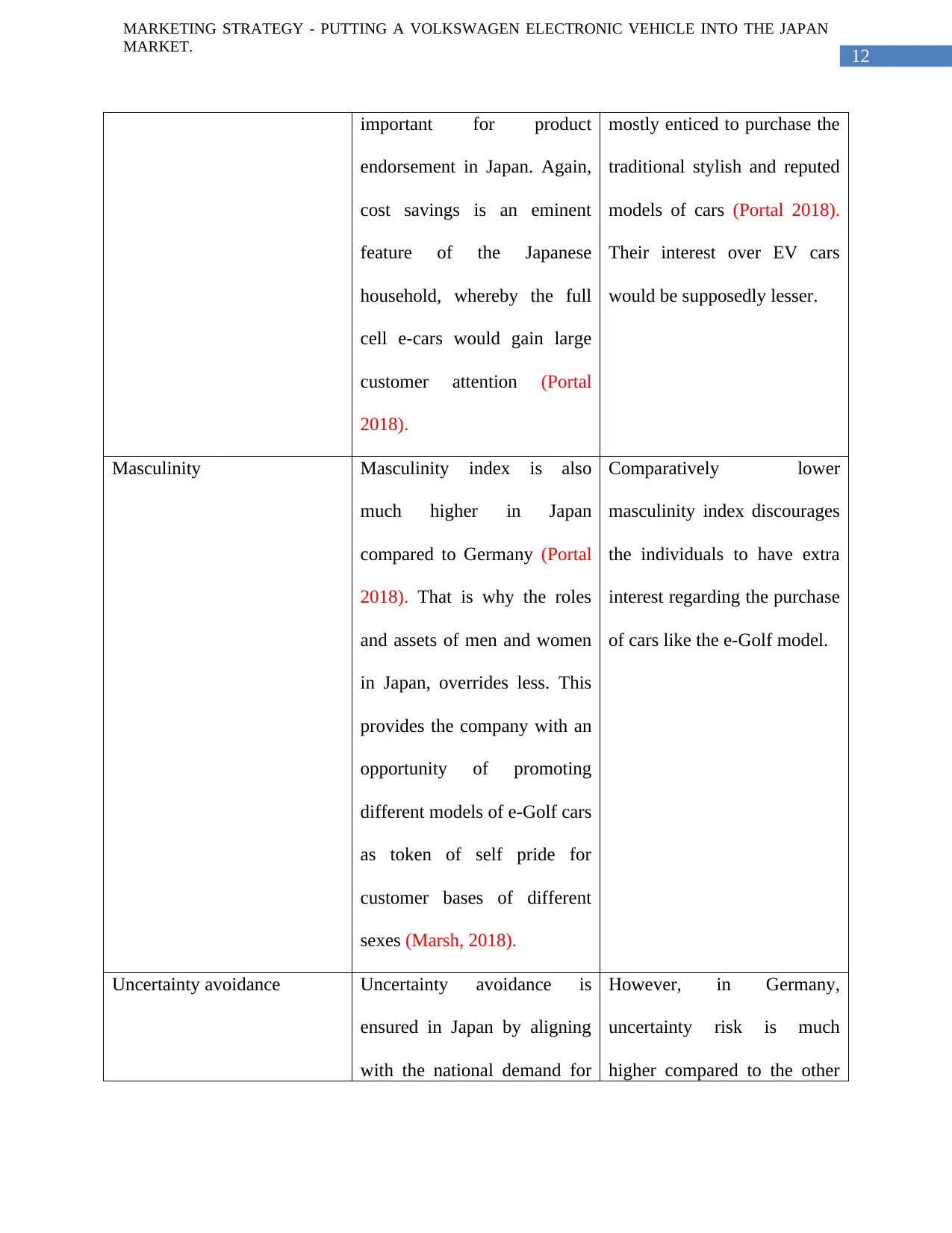
12
MARKETING STRATEGY - PUTTING A VOLKSWAGEN ELECTRONIC VEHICLE INTO THE JAPAN
MARKET.
important for product
endorsement in Japan. Again,
cost savings is an eminent
feature of the Japanese
household, whereby the full
cell e-cars would gain large
customer attention (Portal
2018).
mostly enticed to purchase the
traditional stylish and reputed
models of cars (Portal 2018).
Their interest over EV cars
would be supposedly lesser.
Masculinity Masculinity index is also
much higher in Japan
compared to Germany (Portal
2018). That is why the roles
and assets of men and women
in Japan, overrides less. This
provides the company with an
opportunity of promoting
different models of e-Golf cars
as token of self pride for
customer bases of different
sexes (Marsh, 2018).
Comparatively lower
masculinity index discourages
the individuals to have extra
interest regarding the purchase
of cars like the e-Golf model.
Uncertainty avoidance Uncertainty avoidance is
ensured in Japan by aligning
with the national demand for
However, in Germany,
uncertainty risk is much
higher compared to the other
MARKETING STRATEGY - PUTTING A VOLKSWAGEN ELECTRONIC VEHICLE INTO THE JAPAN
MARKET.
important for product
endorsement in Japan. Again,
cost savings is an eminent
feature of the Japanese
household, whereby the full
cell e-cars would gain large
customer attention (Portal
2018).
mostly enticed to purchase the
traditional stylish and reputed
models of cars (Portal 2018).
Their interest over EV cars
would be supposedly lesser.
Masculinity Masculinity index is also
much higher in Japan
compared to Germany (Portal
2018). That is why the roles
and assets of men and women
in Japan, overrides less. This
provides the company with an
opportunity of promoting
different models of e-Golf cars
as token of self pride for
customer bases of different
sexes (Marsh, 2018).
Comparatively lower
masculinity index discourages
the individuals to have extra
interest regarding the purchase
of cars like the e-Golf model.
Uncertainty avoidance Uncertainty avoidance is
ensured in Japan by aligning
with the national demand for
However, in Germany,
uncertainty risk is much
higher compared to the other
⊘ This is a preview!⊘
Do you want full access?
Subscribe today to unlock all pages.

Trusted by 1+ million students worldwide
1 out of 33
Related Documents
Your All-in-One AI-Powered Toolkit for Academic Success.
+13062052269
info@desklib.com
Available 24*7 on WhatsApp / Email
![[object Object]](/_next/static/media/star-bottom.7253800d.svg)
Unlock your academic potential
Copyright © 2020–2025 A2Z Services. All Rights Reserved. Developed and managed by ZUCOL.





